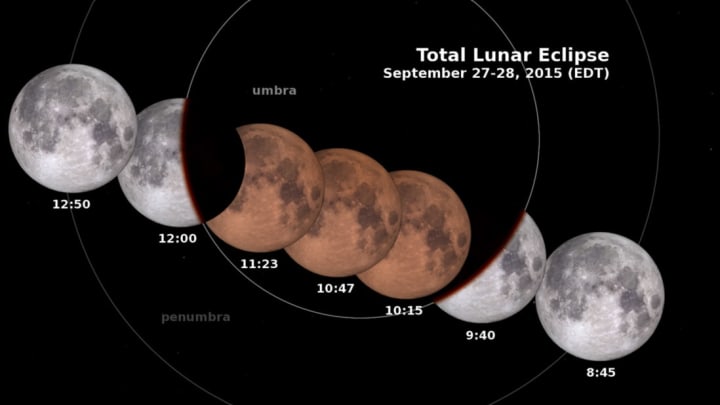You Can See a Rare Total Eclipse of a Red Super Harvest Moon

On Sunday September 27, something rare and wonderful will happen: the Moon will be full, it will be as near to us as it gets, and it will line up perfectly with the Earth and Sun. The result will be a rare total super harvest moon eclipse, when a giant, full Moon will turn a stunning shade of red.
In celestial terms, that's like a Super Bowl played by Academy Award nominees, with the winner revealing who killed Laura Palmer. It's the only one in a 51-year period; the last supermoon eclipse occurred in 1982, and the next won't come around until 2033. Don't miss it or you'll have to wait 18 years.
WHAT IS GOING ON UP THERE?
We've known for at least 2500 years what a lunar eclipse is thanks to Anaxagoras, a Greek philosopher, who worked out the mechanics in the 5th century BCE. Though we've been recording eclipses for millennia, they never fail to inspire a sense of awe and wonder.
So how does this rare total super harvest moon eclipse come about? You've probably noticed that the Moon appears to be different sizes at various points throughout the year. This is because the Moon's orbit around the Earth is not circular but elliptical. When the Moon is nearest to the Earth on its orbit, it is at "perigee." When it is farthest away, it is at "apogee." At perigee, the Moon appears giant, and at apogee, small.
Note that this is unrelated to the Moon's phases, which are determined by the relative positions of the Sun, Earth, and Moon. For example, when the Earth is between the Moon and the Sun, you see a full moon, because we're looking at the fully sunlit side of the Moon. The three bodies rarely line up exactly, but when they do, you get a total lunar eclipse.
Bringing the two concepts together: When the Moon's phase is full and it is at perigee (i.e. closest to the Earth, and thus giant), you get what astronomers call perigee-syzygy, or, colloquially, a "supermoon." Now add the date to the equation: September is harvest time for farmers, making a full moon that month a "harvest moon." Why? In the days before light bulbs, farmers could use this extra moonlight to harvest crops late into the night.
This weekend the Moon will be full, it will be at perigee, and it will line up perfectly with the Earth and Sun. Because all of this is happening in late September, you get a total super harvest moon eclipse! It's like a moon named by the people who make sequels to Street Fighter.
WHEN TO LOOK UP
On September 27 at 9:07 p.m. EST, the Moon will begin traveling through the Earth's shadow. At 10:11 p.m., the Moon will be fully eclipsed, and will turn an amazing shade of red. The show will last 72 minutes.
But why will it be red? From the vantage point of the Moon, the Earth will appear to be moving across the Sun. Once the Earth is directly between the Moon and the Sun, as NASA evocatively explains, "the darkened terrestrial disk is ringed by every sunrise and every sunset in the world, all at once." The copper sky filters into the shadow of the Earth and is projected onto the white disk that is the Moon. Here's a shockingly crimson Moon as seen from Australia in August 2007.
Image credit: Martin Pugh via NASA